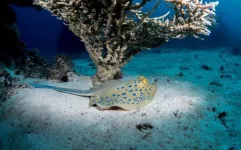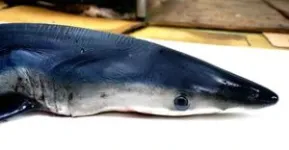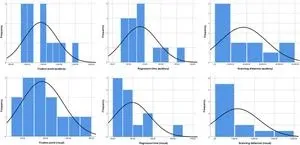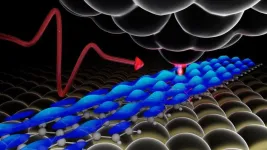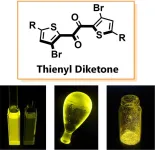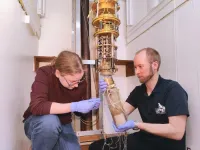Researchers have discovered the unique nanostructures responsible for the electric blue spots of the bluespotted ribbontail ray (Taeniura lymma), with possible applications for developing chemical-free colouration. The team are also conducting ongoing research into the equally enigmatic blue colouration of the blue shark (Prionace glauca).
Skin colouration plays a key role in organismal communication, providing life-critical visual clues that can warn, attract or camouflage. Bluespotted ribbontail rays possess striking electric blue spots on their skin, however, the biological processes that produced these electric blue spots was a mystery, until now.
“If you see blue in nature, you can almost be sure that it’s made by tissue nanostructures, not pigment,” says Mason Dean, Associate Professor of Comparative Anatomy at City University of Hong Kong (CityU). “Understanding animal structural colour is not just about optical physics but also the materials involved, how they’re finely organized in the tissue, and how the colour looks in the animal’s environment. To draw all those pieces together, we assembled a great team of disciplines from multiple countries, ending up with a surprising and fun solution to the stingray colour puzzle.”
Structural colours are produced by extremely small structures that manipulate light, rather than as a product of chemical pigments. “Blue colours are especially interesting because blue pigments are extremely rare, and nature often uses nanoscale structures to make blue,” says Viktoriia Kamska, a postdoc studying natural colouration mechanisms at CityU. “We're particularly interested in ribbontail stingrays because, unlike most other structural colours, their blue colour doesn't change when you look at them from different angles.”
The research team combined a variety of techniques to understand the skin architecture under different natural conditions. “To understand the fine-scale architecture of the skin, we used microcomputed tomography (micro-CT), scanning electron microscopy (SEM), and transmission electron microscopy (TEM),” says Dr Dean.
“We discovered that the blue colour is produced by unique skin cells, with a stable 3D arrangement of nanoscale spheres containing reflecting nanocrystals (like pearls suspended in a bubble tea),” says Amar Surapaneni, a postdoc with Mason Dean’s group until recently and now a visiting academic at Trinity College Dublin. “Because the size of the nanostructures and their spacing are a useful multiple of the wavelength of blue light, they tend to reflect blue wavelengths specifically.”
Interestingly, the team discovered that the unique “quasi-ordered” arrangement of the spheres helped to ensure the colour remained unchanged with viewing angle. “And to clean up any extraneous colours, a thick layer of melanin underneath the colour-producing cells absorbs all other colours, resulting in extremely bright blue skin,” says Dr Dean. “In the end, the two cell types are a great collaboration: the structural colour cells hone in on the blue colour, while the melanin pigment cells suppress other wavelengths, resulting in extremely bright blue skin.”
The team believe that this fascinating blue colouration is likely to provide camouflage benefits to the stingrays. “In water, blue penetrates deeper than any other colour, helping animals blend with their surroundings,” says Dr Dean. “Bright blue skin spots of stingrays do not change with viewing angle; therefore, they might have specific advantages in camouflage as the animal is swimming or quickly manoeuvring with undulating wings.”
The applications for this research currently being explored include bio-inspired pigment-less coloured materials. “We are pursuing collaborations with fellow researchers to develop flexible biomimetic structurally-coloured systems inspired by the soft nature of stingray skin for safe, chemical-free colours in textiles, flexible displays, screens, and sensors,” says Dr Dean.
As well as their work on stingrays, Dr Kamska and her team are also investigating the blue colouration of other rays and sharks, including the blue shark. “Despite the name 'blue shark' and its ecological aspects being well studied, no one still knows how the blue colour is produced on its skin,” says Dr Kamska. “Preliminary results demonstrate that this coloration mechanism is different from the stingray's - but just like the stingray, we need to try different combinations of fine imaging tools and address multiple related disciplines in optics, material, and biological science.”
This research was published in Advanced Optical Materials titled “Ribbontail Stingray Skin Employs a Core–Shelf Photonic Glass Ultrastructure to Make Blue Structural Color”.
There is also a forthcoming article in Frontiers in Cell and Developmental Biology, titled “Intermediate filaments spatially organize intracellular nanostructures to produce the bright structural blue of ribbontail stingrays across ontogeny.”
The research is supported by the University Grant Committee with the General Research Fund at the City University of Hong Kong.
This research is being presented at the Society for Experimental Biology Annual Conference in Prague on the 2-5 July 2024.
END
A New Blue: Mysterious origin of the ribbontail ray’s electric blue spots revealed
2024-07-04
(Press-News.org)
ELSE PRESS RELEASES FROM THIS DATE:
Cool roofs are best at beating cities’ heat
2024-07-04
Painting roofs white or covering them with a reflective coating would be more effective at cooling cities like London than vegetation-covered “green roofs,” street-level vegetation or solar panels, finds a new study led by UCL researchers.
Conversely, extensive use of air conditioning would warm the outside environment by as much as 1 degree C in London’s dense city centre, the researchers found.
The research, published in Geophysical Research Letters, used a three-dimensional urban climate model of Greater London to test the thermal effects of different passive and active urban heat management systems, including painted “cool roofs,” rooftop solar panels, ...
Single atoms show their true color
2024-07-04
One of the challenges of cramming smarter and more powerful electronics into ever-shrinking devices is developing the tools and techniques to analyze the materials that make them up with increasingly intimate precision.
Physicists at Michigan State University have taken a long-awaited step on that front with an approach that combines high-resolution microscopy with ultrafast lasers.
The technique, described in the journal Nature Photonics, enables researchers to spot misfit atoms in semiconductors with unparalleled precision. Semiconductor physics labels these atoms as “defects,” which sounds negative, but they’re ...
Re-engineering cancerous tumors to self-destruct and kill drug-resistant cells
2024-07-04
UNIVERSITY PARK, Pa. — Treating cancer can sometimes feel like a game of Whac-A-Mole. The disease can become resistant to treatment, and clinicians never know when, where and what resistance might emerge, leaving them one step behind. But a team led by Penn State researchers has found a way to reprogram disease evolution and design tumors that are easier to treat.
They created a modular genetic circuit that turns cancer cells into a “Trojan horse,” causing them to self-destruct and kill nearby drug-resistant ...
Reversing chemotherapy resistance in pancreatic cancer
2024-07-04
Pancreatic cancer is a particularly aggressive and difficult-to-treat cancer, in part because it is often resistant to chemotherapy. Now, researchers at Stanford have revealed that this resistance is related to both the physical stiffness of the tissue around the cancerous cells and the chemical makeup of that tissue. Their work, published on July 4 in Nature Materials, shows that this resistance can be reversed and reveals potential targets for new pancreatic cancer treatments.
“We found that stiffer tissue can cause pancreatic cancer cells to become resistant to chemotherapy, while softer tissue made ...
New organic molecule shatters phosphorescence efficiency records and paves way for rare metal-free applications
2024-07-04
A research team led by Osaka University discovered that the new organic molecule thienyl diketone shows high-efficiency phosphorescence. It achieved phosphorescence that is more than ten times faster than traditional materials, allowing the team to elucidate this mechanism.
Osaka, Japan – Phosphorescence is a valuable optical function used in applications such as organic EL displays (OLEDs) and cancer diagnostics. Until now, achieving high-efficiency phosphorescence without using rare metals such as iridium and platinum has been a significant challenge. Phosphorescence, which occurs when a molecule transitions ...
International summit of experts in nuclear physics at the University of Barcelona
2024-07-04
More than two hundred international experts will take part in the 10th International Conference on Quarks and Nuclear Physics (QNP2024), a scientific summit organized by the UB Institute of Cosmos Sciences (ICCUB), which will be held in the Aula Magna of the Faculty of Biology at the University of Barcelona from 8 to 12 July. This meeting, hosted by the UB for the first time, will bring together world experts in the fields of nuclear physics and hadronic physics to discuss the latest advances in theory, experimentation and technology ...
Clever pupils don’t need to attend academically selective schools to thrive, study finds
2024-07-04
Findings published in a new peer-reviewed paper in the British Journal of Educational Studies challenges the idea that academically selective schools are necessary for clever pupils to achieve good outcomes.
Selective schools are government-funded schools that enrol only the highest performing students. Pupils take a standardized entrance exam, from which the best-scoring are enrolled.
Some argue that selective schools are necessary for bright pupils to reach their full academic potential. Selective schools can ...
Searching for dark matter with the coldest quantum detectors in the world
2024-07-04
One of the greatest mysteries of science could be one step closer to being solved.
Approximately 80% of the matter in the universe is dark, meaning that it cannot be seen. In fact, dark matter is passing through us constantly – possibly at a rate of trillions of particles per second.
We know it exists because we can see the effects of its gravity, but experiments to date have so far failed to detect it.
Taking advantage of the most advanced quantum technologies, scientists from Lancaster University, the University of Oxford, and Royal Holloway, ...
UNSW Sydney's Dr Vaishnavi Ananthanarayanan receives RMS Award for Life Sciences
2024-07-04
This accolade highlights her pioneering research in the use of a diverse array of advanced microscopy techniques to uncover fundamental biophysical processes.
Currently holding a prestigious EMBL (European Molecular Biology Laboratory) Australia Group Leader fellowship, Dr Ananthanarayanan leads one of the largest and most dynamic research group in the EMBL Australia Node in Single Molecule Science, based in the Department of Molecular Medicine in the School of Biomedical Sciences.
Her research, which focuses on motor proteins and cytoskeleton dynamics, has set new standards ...
Researchers unveils a critical role of the lateral septum in drug addiction
2024-07-04
Recently, a research team led by Dr. ZHU Yingjie from the Shenzhen Institute of Advanced Technology, Chinese Academy of Sciences has published a study in Neuron, the study presents a comprehensive transcriptional profile of the lateral septum (LS) at the single-cell level, elucidating the spatial distribution of its major neuronal types. The study shows that neurons expressing estrogen receptor 1 (LSEsr1), predominantly located in the ventral subregion of LS, play a crucial role in reward-seeking and methamphetamine (METH) addiction.
In 1954, psychologists Olds and Milner discovered the brain's reward system through intracranial ...
